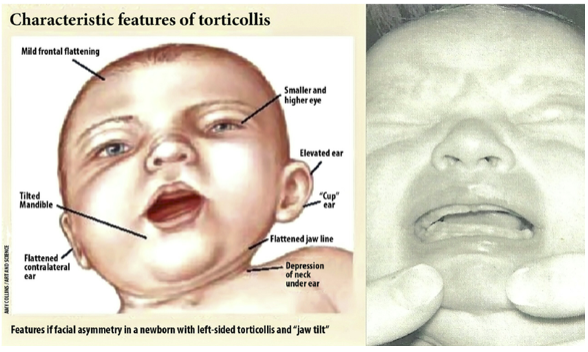Infant torticollis, also called wryneck or loxia, is a persistent, involuntary turning of the head to one side or the other, with the chin pointing upward. It may be genetic, or the result of a birth injury, or persistent mispositioning of the infant. It may be present at birth or develop as the infant grows older.
What Are the Symptoms?
Sometimes, torticollis is obvious. The infant has his or her head turned to one side and seems unable to turn it the other way or has a very limited range of motion. Other signs are subtler and may require a medical diagnosis. These include: persistent turning of the head to one side, headache (very difficult to diagnose infants), head tremors, neck pain, one shoulder constantly higher than the other, neck muscle stiffness, neck muscle swelling, and persistently pointing the chin upwards.
Is It Painful for the Infant?
This depends on the severity of the torticollis and what else is going on. Symptoms can include headache and neck pain, but in an infant who cannot yet talk, it can be every hard to distinguish from infant distress that has other causes. On the other hand, the neck may be tender or in spasm, and it will be obvious if gentle turning of the head in the direction opposite to the twist causes the infant pain. It all depends on the source of the problem, how severe it is, and how the infant reacts to it. Some infants may be in quite a bit of pain, while others will not appear to notice it. Even if the infant is not distressed, however, it is not a normal condition and needs to be dealt with medically. It is also much harder to treat successfully if care is delayed.
What Does It Look Like?

How Is It Diagnosed?
As noted, sometimes it’s obvious. If it’s not, the diagnostic modalities available include CAT scans, MRI scans, and electromyography (EMG) of the neck to determine if the response of the neck muscles is normal. A physical exam will reveal whether the neck muscles are shortened and whether the head persistently tilts to one side with the chin up.
What Are the Causes?
Birth injury is one cause. This can consist of too forceful application of delivery forceps, vacuum extraction injury, or too-vigorous pulling in the infant during delivery. Acquired, rather than genetic, causes, include spinal misalignment while in the womb or abnormal presentation during delivery, such as the breech position.
After birth, torticollis may occur due to tonsillitis, tumors both benign and malignant, falling from high places, other accidents affecting the head and neck, or too much time spent lying down in car seats, strollers, and the like. Grisel’s syndrome, in which swelling (inflammation) of the tissues surrounding the atlanto-axial joint (where the head and the spine meet) forces the joint out of alignment, is a rare cause. The most common finding at surgery is a fibrous mass within the sternocleomastoid muscle, which is the primary muscle responsible for turning the head.
How Common is It?
Infant torticollis is the third most common congenital deformity. About one in 250 babies are born with torticollis, making it a relatively common birth condition. About one in 20 babies born with torticollis also have hip dysplasia, in which the socket of the hip joint does not fully contain the ball at the top of the thigh bone. Figures on acquired torticollis (developed after birth) are less exact.
Can It Be Prevented?
Since the bulk of infant torticollis is due to birth injury, the only preventive measure we can take now – according to doctors – is to encourage doctors to be gentle and careful during deliveries. And for the small portion caused by persistent lying down in the wrong position, make sure the child’s position is proper and check it frequently.
What Are the Allopathic Treatment Options?
If torticollis is present at birth, the only recommended treatment in allopathic (traditional) medicine is gentle stretching, followed by physical therapy when the infant is older. Surgery should not be considered until after the infant is four years old (some experts say one) and all other treatments have failed. Other treatments that can be tried up to age four include heat, traction, and massage therapy; medication, and routine periodic injections of botulinum toxin, which temporarily paralyzes the muscles causing the abnormal head tilt. None of these methods are guaranteed to work, including physical therapy.
What Are the Chiropractic Treatment Options?
Chiropractic medicine takes a holistic view of both the illness and the patient. The chief approaches, some of which overlap with those used by allopathic medicine, are adjustments of the spine, head, and neck. Adjustments to both the cranial bones and the soft tissues can be made. Chiropractors generally do not use medications but may offer supplements as an adjunct to treatment.
What About Surgery?
Allopathic physicians agree that surgery should be reserved for children over four (some experts say one) for whom all other treatments have failed. Only around 5% of children with torticollis are treated with surgery. The surgical technique varies, but the general aim is to lengthen the sternocleomastoid muscle, usually by cutting the fibrous internal mass which is often sound within the muscle. Most surgery is done with an open approach, but research for laparoscopic approaches is ongoing. The most common complication is hematoma (a collection of blood under the skin that results in a swelling.) A very few children may require more than one operation for the best cosmetic result.
What Is Chiropractic Treatment For Infantile Torticolis Like?
At the initial visit, the doctor will take a careful history of the child. If there is any doubt about the diagnosis, an order of any additional tests, such as an X-rays, may be needed. Once a diagnosis of infant torticollis is confirmed, and the degree of misalignment is determined, the doctor will use the appropriate cranioskeletal or other manipulation techniques to begin the process of treatment. Because the objective will be to correct any misalignment and relax or lengthen the muscle, immediate results cannot be expected. Muscles do not lengthen to normal from an abnormally contracted position instantly, and trying to move too fast risks injury or failure of the treatment, so several visits will be required.







